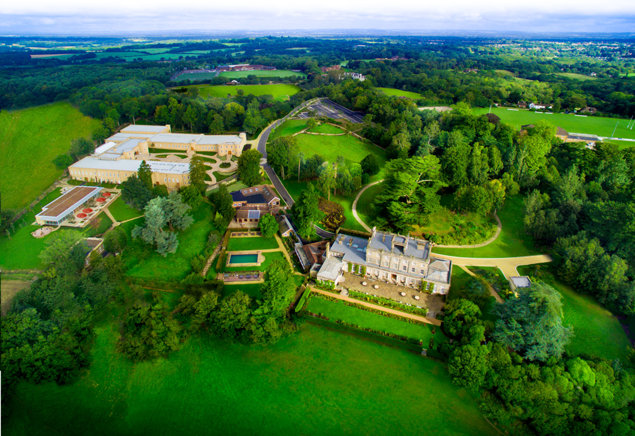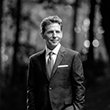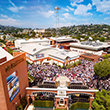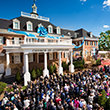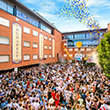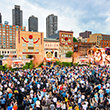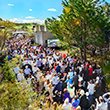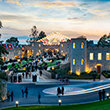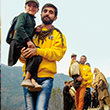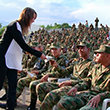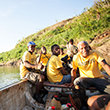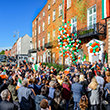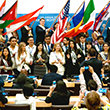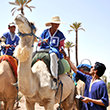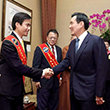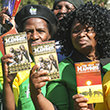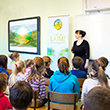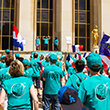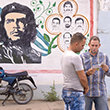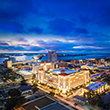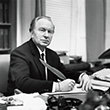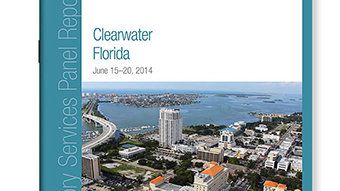East Grinstead, England—As evening settles over Saint Hill, a few scattered clouds linger overhead; a light October chill and a cacophony of languages float on the air. Guests in black ties, evening gowns and ethnic attire transcend cultures as they form one crowd from 65 nations and are greeted, welcomed and funneled up the stairs toward an elaborate stage. Cameras flash and a contingent of bagpipers in traditional kilts add their unique festivity. Anticipation is palpable.
It is the eve of the seventh day of the tenth month—the anniversary of the founding of the International Association of Scientologists (IAS). Its members and guests have gathered for each of the past 32 years to mark the association’s birth on this date, in this sylvan and peaceful setting that was once home to author, humanitarian and Scientology Founder L. Ron Hubbard.
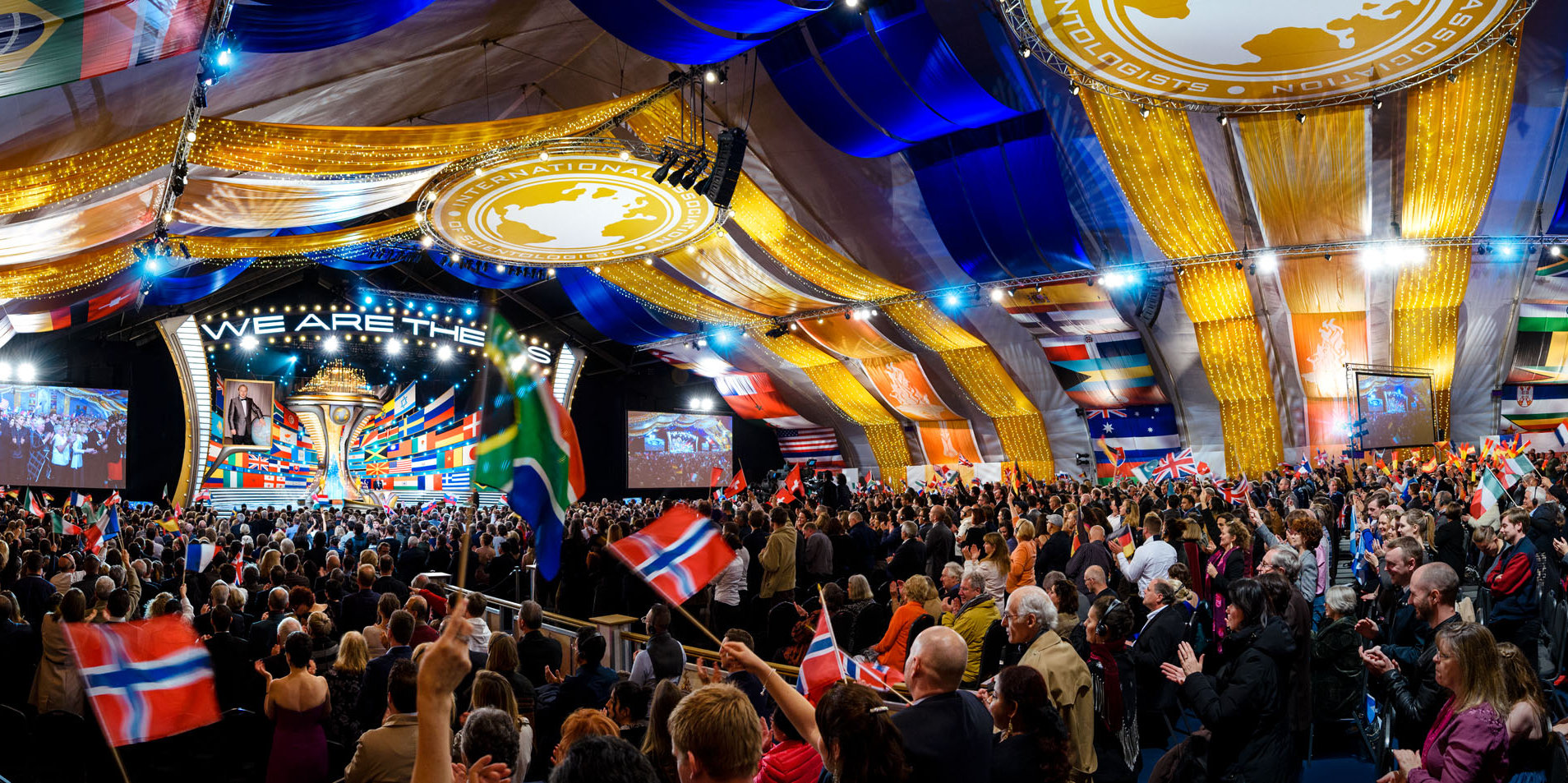
This is a special year, marking 12 months of perhaps the most prolific growth in Church history. Members have come to commemorate not only the opening of a massive new regional center for the Asia Pacific region in Sydney, Australia, and new facilities in Harlem, New York; Atlanta, Georgia; and Budapest, Hungary, but also to celebrate the Church’s mission work in humanitarian causes that has borne witness to the depth—and in many cases the courage—of IAS-supported campaigns.
It is also the first of three nights of celebration to honor the humanitarian commitment of a membership organization that, since 1984, has paved the way to global growth and the support of those who have dedicated themselves to good works for their fellow man. Tonight is no different, except that the milestones marked here illuminate a steady path of progress in what was first a dream and then a reality, now reflected in millions of lives touched, people served and hope generated.
In opening the presentations, Scientology ecclesiastical leader David Miscavige noted that not only has the Church experienced a year of record growth—with the opening of new Churches and facilities around the world—but that the secular missions of humanitarian assistance also recorded a banner year.
“Welcome to the glory of the IAS,” he told the assembled members and guests, which included past IAS Freedom Medal winners dating to the association’s first annual conferences. “Welcome to a glory surpassing any glory since we first pledged ourselves to mankind.”
As he described the events that have made the past year unique, Mr. Miscavige cited in particular the work of Scientology Volunteer Ministers both in disaster zones and local communities around the world; the inroads made by this year’s courageous campaigns for human rights recognition among soldiers in war-torn Colombia; drug education outreach brought to educators, students and parents; and work to expose psychiatric abuses.
“And so, to hold these beliefs as self-evident—that whoever infringes on the rights of one, infringes on the rights of all, and a failure to salute the lowest human being is a failure to salute humankind,” Mr. Miscavige said, “in the same breath, we also pledged to recognize the magic in every living thing and thus, the majesty of the IAS. While beyond even that, let it be said you don’t make that kind of pledge unless you can live up to it, which, of course, we can.”
That commitment was reflected in each of 2016’s IAS Freedom Medal winners—Sandra and Felipe Poveda of Bogotá, Colombia; Ben and Meghan Fialkoff of New York City; and Shelley Wilkins, of Sydney, Australia—whose stories unfolded during the evening, outlining the details of humanitarian efforts that IAS members have supported financially, emotionally and spiritually.
The Fialkoff father-daughter team was awarded the Freedom Medal for their ongoing work in bringing “The Truth About Drugs” education to tens of thousands of New York City youth, helping generate the first drug usage drop among teens in more than a decade. Their effort began, Ben said, after he was moved by appeals of Church and IAS members to get involved.
“I was confronted with making a personal commitment, a large commitment,” the prominent New York periodontal surgeon said in an interview later. “I remember that I went out into the rain one night and began walking around [the patio] thinking, can I do this? Can I do this? My family came out and said, ‘Dad, why are you walking in the rain?,’ and I said, ‘It’s okay, let me think. I’m thinking.’”
When he came inside, he said, his decision was made, and he and his daughter Meghan together launched the first of their efforts to contact New York City police, political interests and organizations, seeking acceptance and cooperation in what has now turned into a successful region-wide campaign on drug education for young people. In their turn, those officials have helped take the campaign’s anti-drug messages and materials into schools, community centers and city streets through more than 1,000 meetings and community sessions.
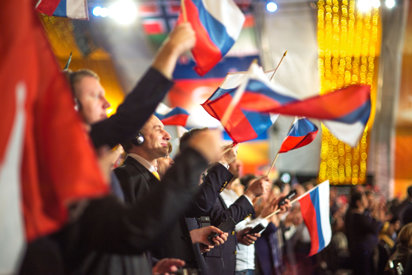
More recently, Ben—a refugee in 1962 from Castro’s Cuba—and Meghan expanded their work into Central America, meeting with military and government officials in Haiti, Guatemala, the Dominican Republic, El Salvador and elsewhere, generating new support for drug prevention education in countries where combating the spread of drug-related social ills, exacerbated by illegal drug trafficking, is an everyday job.
“We took on the challenge because we believe that this works,” Ben Fialkoff said. “And it does work.”
Sandra and Felipe Poveda also reflected those commitments in a similar context, meeting a unique challenge through the United for Human Rights and Youth for Human Rights campaigns.
In 2008, while Felipe was still a teenager, the siblings began to approach military and government leaders in their native Colombia with the idea of educating soldiers about protecting rather than violating human rights in the war-ravaged country, where 52 years of armed conflict has only in recent days led to a ceasefire and peace negotiations.
It was a decision, Mr. Miscavige noted, that carried considerable risk, and he remarked upon the Povedas’ courage.
“It’s a story,” he told IAS members, “in emphasis of the fact that those who stand upon this stage are not infrequently secret players behind world headlines. It’s also one to remind us they will just as frequently go to dangerous extremes in pursuit of peace and IAS greatness. Not that risking one’s life is requisite to winning the Freedom Medal, but when they pull it off, the stories are staggering.”
In meetings in jungle camps of government soldiers, Sandra, a Bogotá dentist, and her brother, a musician and creative artist, were a “non-threatening” and earnest presence, boldly talking to soldiers about compassion, about their difficulties in the field, and in pointed language about assassinations, kidnappings, rapes, terrorism and other war crimes perpetrated by both the military and rebels in violation of the United Nations Declaration on Human Rights.
“They listened,” Sandra said in an interview later. “They heard us.”
The programs included re-enactments of situations in which soldiers might be faced with deciding whether to protect human rights, or to use illegal force or inflict trauma. The point was to help them better understand their moral and ethical responsibilities, and the import of those decisions on their own humanity.
At one point, Sandra said, when one military commander learned of the meetings, he was enraged that he’d not been consulted for permission, and he summarily cancelled and prohibited the meetings. But she was not deterred.
“We could not let that happen,” she said. And so she contacted others within the military who had supported her and asked for their help. They interceded and restored the program, which ultimately educated 300,000 servicemen and helped transform human rights in the nation.
In Australia, Freedom Medal honoree Shelley Wilkins, National Director of the Citizens Commission on Human Rights, used the nation’s Freedom of Information laws to tackle psychiatric abuse in hospitals and mental health facilities where abuse was occurring.
Through the public record, she uncovered conflicts of interest by psychiatric professionals who had undisclosed links to pharmaceutical companies pushing psychiatric drugs. The disclosures created a media firestorm. Wilkins exposed misappropriation of funds, documented unreported adverse reactions among children to harmful psychiatric pharmaceuticals, and other abusive practices.
In the end, the exposés resulted in legislation to ban sterilization of patients in mental facilities and to prohibit electroshock “therapy” on children.
The program also highlighted other milestones in the past year made possible by IAS members, and detailed the accomplishments of both the United for Human Rights and Youth for Human Rights efforts, bringing messages of tolerance and respect through events staged in more than 100 cities.
With the help of national police on Venezuela’s popular resort island of Margarita, volunteers and officers distributed some 180,000 copies of The Way to Happiness, the secular guide for healthy and rewarding lives developed by Mr. Hubbard through his 21 precepts for living.
In the United States, leaders of the Boy Scouts of America, the youth organization founded in 1910 to teach self-sufficiency, respect for others, and ethical values, teamed up with the Church-sponsored The Truth About Drugs campaign to distribute anti-drug education materials to Scouts, and to make that education a part of the Scouts’ merit badge requirements.

The weekend of events included awards honoring major contributors to the IAS, who have supported the Church’s humanitarian work going on around the world. Activities underwritten by those contributions included response teams of Volunteer Ministers (VMs)—made up of both Scientologists and non-Scientologists—who have provided aid to victims of earthquakes and other natural disasters, and worked closely with government agencies and service groups to build relationships improving emergency services. Since its inception, the VM program has brought aid to more than 3 million people.
The annual event concluded on October 9 with the annual charity concert for the East Grinstead community, including sizeable donations in support of community service programs in the area for young people and the elderly, as well as a contribution to help preserve the local Bluebell Railway, a part of East Sussex history for well over 100 years.
The Church support for local charities in East Grinstead began when Mr. Hubbard initiated contributions in the 1960s as owner and resident of Saint Hill Manor, funding firefighting and other community services and creating a tradition that has continued since then.
During the presentations, East Grinstead Mayor Bob Mainstone took a few moments for an impromptu speech before the 1,500 community members who had gathered for the concert, telling of his own experience with Saint Hill.
“I’m going to say something now that I really haven’t ever had the chance to say before in front of so many people, and I’d like to just turn to the gentleman you see … at this side of the screen, Mr. Hubbard, who … became involved when he lived here with the community,” the mayor said.
“He took part in several activities and supported charities and what’s happened since that time is that you have continued to do that and you have become a most important part of the East Grinstead community. You’re very … very precious to us.”
For Mr. Miscavige, that message carried special meaning.
In a private gathering later that evening, in a softly lit room in Saint Hill Manor, he met with Mr. Mainstone, former mayors and councilors of the city, and their wives, to offer them a special thanks for their years of partnership.
“This is where I grew up,” Mr. Miscavige said, after reading aloud a personal note he had written to Mayor Mainstone—who some 40 years ago had been his teacher in public school, a mentor, an influence on his life, and a friend throughout those years.
“I still consider East Grinstead my home,” he said.
